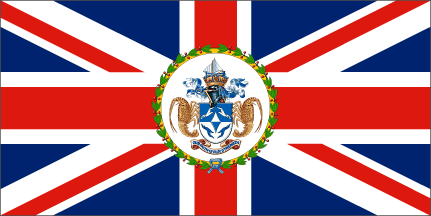 Image
by Graham Bartram, 20 Oct 2002
Image
by Graham Bartram, 20 Oct 2002
Last modified: 2019-01-16 by bruce berry
Keywords: tristan da cunha | saint helena | atlantic ocean |
Links: FOTW homepage |
search |
disclaimer and copyright |
write us |
mirrors
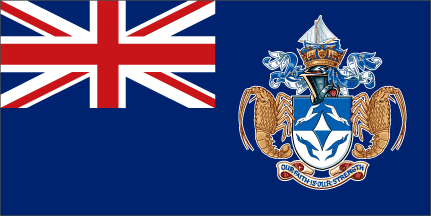
![[State Flag]](../misc/xoxxxx.gif) 1:2
Image
by Graham Bartram, 20 Oct 2002
1:2
Image
by Graham Bartram, 20 Oct 2002See also:
Tristan da Cunha is administered as part of the British overseas territory of Saint Helena and adopted its own flag on 20 October 2002, in a proclamation made by the Governor of Saint Helena under Royal Warrant. Both the flags of the dependency and the Governor are described in the proclamation.
TRISTAN DA CUNHA
The Blue Ensign of Her Majesty¹s fleet defaced in the fly by the full Armorial Ensigns of the Territory, as granted by Royal Warrant of Her Majesty the Queen, that is to say, for Arms, Per Fess Azure and Argent between four yellow-nosed Albatrosses volant outwards in lozenge the two in base reversed a Lozenge embowed inwards all counterchanged and for the Crest upon a Helm Within a Naval Crown Or a Cap Azure thereon a Tristan da Cunha Longboat Argent the gunnel bow stern and rudder Azure the booms and mast Or and for the Supporters On either side a Tristan da Cunha Spiny Lobster Or together with this Motto Our Faith is our Strength, as the same are in the painting hereunto annexed more plainly depicted. This flag to be used on land and at sea as a courtesy ensign.
The (British) Blue Ensign shows the arms in full detail, as they would look if printed. A slightly simplified colour scheme exists for appliquéing the badge, which omits much of the shading.
As you can see from the wording of the proclamation the Blue Ensign is
specifically made the courtesy ensign for Tristan da Cunha. Now that the
badge has been defined, a separate warrant from the Ministry of Defence is
required to allow vessels belonging to, or chartered by, the Government of
Tristan da Cunha to fly the defaced Blue Ensign. At present Tristan does
not have a shipping register of its own so does not need a defaced Red
Ensign.
Graham Bartram, 20 Oct 2002
 Image
by Graham Bartram, 20 Oct 2002
Image
by Graham Bartram, 20 Oct 2002
The Administrator's flag can be used on land and at sea, as a distinguishing flag. Unusually it's not limited to Tristan, which reflects the position of Tristan as a dependency of Saint Helena, where the Administrator can also use his flag, and even more uniquely at Tristan House in Cape Town, the mainland office/residence of Tristan in South Africa.
The design of the Blue Ensign follows the modern pattern for British
Overseas Territories, but during the design phase several different design
elements were proposed, including potato plants and wavy white lines, but
in the end the Island Council chose the standard design.
Graham Bartram, 20 Oct 2002
Tristan da Cunha in the 20th Century
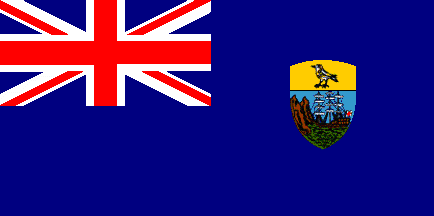 Image
by Blas Delgado Ortiz, 11 Sept 2000
Image
by Blas Delgado Ortiz, 11 Sept 2000
Tristan da Cunha is a dependency of St. Helena. Prior to adoption of current flag in 2002, the correct flags were
the British Union Flag and the St. Helena
flag. By tradition they put both flags on
the same pole, with the Union Flag uppermost (much like some Americans do
with the Stars & Stripes and State flag).
Graham Bartram, 07 Feb 1998
Tristan da Cunha in the 19th Century
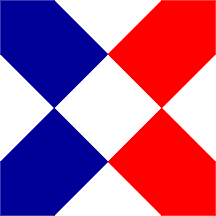 Image
by Željko Heimer, 07 Feb 2002
Image
by Željko Heimer, 07 Feb 2002
A "republic" was proclaimed on Tristan da Cunha by the American Jonathan Lambert around 1811. A description of the flag used can be found in a Dutch vexillological publication [number and title not provided - Ed]. Unfortunately I'm unable to understand the description. I think that the flag is currently in the Public Record Office Museum of London.
According to my own sources, some American filibusters settled
on the island
in 1810. In 1812, during the Anglo-American War the British decided to annex
the island
but this did not take effect until 1816 when Hudson Lowe, Governor of the
Cape Colony,
send a ship. The reason for the delay was the fear that the island might
be used as base by Napoleon's
partisans, aiming for the release of the ex-Emperor. Five officers and 36
senior officers and soldiers took possession of the island on 28 November
1816. The group remained on the island until November 1817 when everyone was
evacuated except for Corporal William Glass and his wife
and two sons, and two other men. Between 1817 and his death in 1853 Glass
governed the territory.
Jaume Olle, 02 June 1997
Regarding the reference to "Hudson Lowe, Cape Governor" in 1812, it seems that
the name Hudson Lowe does not appear on the complete list of governors and
acting governors of the Cape from 1652 to 1910 that I have. The list
for the period in question goes:
1807: Du Pré Alexander, Earl of Caledon, Governor
1811: Acting Governor Lieutenant-General Henry George Grey (July-September)
1811: Governor Lieutenant-General Sir John Francis Cradock (in office until 1813)
Gen Grey was again Acting Governor in 1813 until the arrival of Lord
Charles Somerset, who was Governor until about 1822 or later.
This is not to say that there was not an official at the Cape named Hudson Lowe.
The heraldic blazon might be the best way to describe the flag pattern:
White, a saltire per pale blue and red, pierced of the field.
Mike Oettle, 04 Jan 2002
I've had a query from someone regarding a flag of William Lambert's that he designed for Tristan de Cunha. My query has this description of Lambert's flag, which was published in an unidentified newspaper:
'The flag is formed of four diamonds, transversely from corner to corner, and five half-diamonds placed in the centre, on the top, bottom and both sides. The 2 upper and 2 lower diamonds are blue next the staff or halyard, and red on the outermost side, the centre white, the four half-diamonds bear the letter W.'
David Cohen, 29 Oct 1999
On 27 Dec 1810 the "Baltic" from Boston (Mass), Captain Lovel, put three
men on the shore of Tristan da Cunha, the Italian Tomaso Corri (or
Thomas Currey) from Livorno; an American named Williams, who signed as
Andrew Millet and another American, Jonathan Lambert from Salem, Mass,
who took charge. Lambert pronounced himself sovereign of Tristan da
Cunha and a proclamation was printed in the Boston Gazette of 18 July
1811. In that proclamation he adopted a flag for the islands and a white
flag as the ensign for the merchant fleet of the islands.
Description of the flag, separate in the Boston Gazette of 18 July 1811:
five lozenges standing on their points, and four half lozenges to the
sides top and bottom. The two lozenges to the hoist were blue, the
middle one white, the other two red. The four half lozenges contained
the letter W.
In the Public Record Office Museum in London a flag is mentioned as the
flag of Lambert, which differs from the flag described above.
Lambert and Williams and another American perished at sea on 17 May
1812, after which Corri lived as a Robinson Crusoe on the island; on 5
and 6 March the captain of the "Semiramis" met Corri and presented him
with the Union Jack.
From: Tristan da Cunha 1506-1950, Geschiedenis van een Volkplanting, by
Jan Brander, 1952.
Jarig Bakker, 02 Dec 2000
In a book called "L'Etat c'est moi" by Bruno Fuligni [fuL97]
there's a paragraph about the history of Jonathan Lambert. It is said that "he called Tristan da Cunha "Island of
Rest", pronounced himself emperor, and adopted a *green* flag, with 5
diamonds and 4 half-diamonds, which were blue and red. Then, he sent a
communiqué to the Boston Gazette."
Olivier Touzeau, 03 Dec 2000
Above is a discussion of the role of Hudson Lowe, as the Cape Governor who sent
a ship to Tristan de Cunha circa 1816. As Mike Oettle points out, Lowe was not
Governor of the Cape Colony. Lowe
was Governor of St. Helena and the confusion probably arises because
Lowe had sent a correspondence to the Chief of the Naval Division at
Cape of Good Hope, Rear Admiral Sir Putney Malcolm. This information
was forwarded to the Cape Colony Governor, Lord Somerset.
The 1885 naval accident referred to in the text occurred when a longboat
was capsized when 19 men set off to try and acquire much needed
provisions from the baroque West Riding which had stopped at the island
to take aboard water. The longboat capsized in a squall and all but 4
perished (one of the 4 who survived apparently went insane). There were
apparently additional adult men in the island census, but they were aged
or unable to work.
Source: The Annals of Tristan da Cunha Professor Arnaldo Faustini,
unpublished manuscript transcribed and available from http://www.btinternet.com/~sa_sa/tristan_da_cunha/annals_main.html
in PDF format.
Phil Nelson, 10 Aug2003
On 30 September 1985 Tristan da Cunha issued a four-stamp set illustrating the flags used on the island.
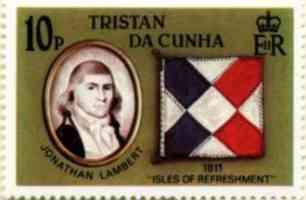
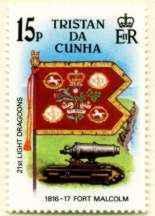
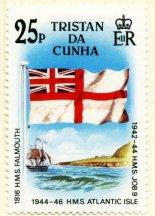
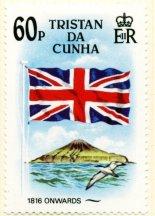 Images posted by Mike Oettle, 02 Jan 2002
Images posted by Mike Oettle, 02 Jan 2002
10p: Jonathan Lambert and the flag he devised for the "Isles of Refreshment" in 1811.
15p: The guidon of the 21st Light Dragoons, which garrisoned Fort Malcolm in 1816 and 1817.
25p: The White Ensign, used on the island initially in 1816 when it was officially HMS Falmouth, then from 1942 to 1944, when it was HMS Job 9, and from 1944 to 1946, when the island was HMS Atlantic Isle.
60p: The Union Jack, used continuously on the island since 1816.
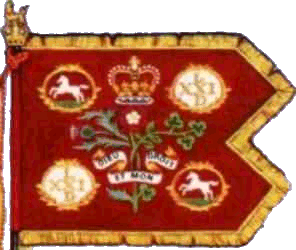 Enlarged detail of the guidon of the 21st Light Dragoons.
Enlarged detail of the guidon of the 21st Light Dragoons.
Mike Oettle, 02 Jan 2002
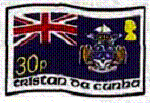 Image from Scott Catalog 2005 and posted by Valentin Poposki, 30 April 2006
Image from Scott Catalog 2005 and posted by Valentin Poposki, 30 April 2006
On 27th July 2004 Tristan da Cuhna postal authorities issued a die-cut self-adhesive stamp showing its new flag (Scott number 751).
Valentin Poposki, 30 April 2006
It seems that an other stamp virtually the same at a quick glance was issued soon afterward with Scott number 804.
Richard Mallett, 30 April 2006




